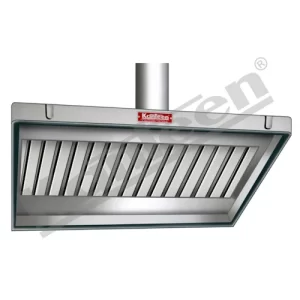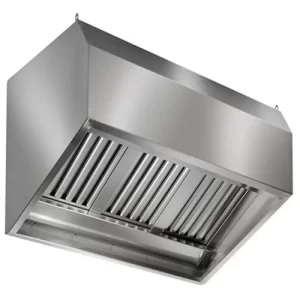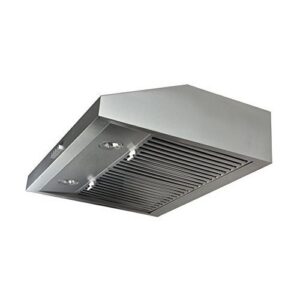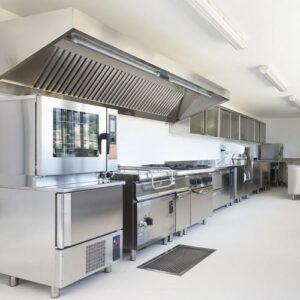Commercial Kitchen Hood
Commercial Kitchen Hoods: The Essential Guide
In the fast-paced environment of a commercial kitchen, maintaining air quality and removing cooking odors, smoke, and grease is crucial. A commercial kitchen hood plays an essential role in ensuring a safe and comfortable workspace for chefs and staff. This comprehensive guide will explore everything you need to know about commercial kitchen hoods, including their types, benefits, installation, maintenance, and FAQs. This content is designed to enhance your ecommerce website’s SEO performance and provide valuable insights to potential buyers.
What is a Commercial Kitchen Hood?
A commercial kitchen hood, often referred to as a range hood or exhaust hood, is a ventilation system installed above cooking equipment to capture and remove smoke, steam, grease, and odors generated during food preparation. Unlike residential hoods, commercial kitchen hoods are designed to handle the demands of high-volume cooking environments, such as restaurants, cafeterias, and catering businesses.
How Does a Commercial Kitchen Hood Work?
The operation of a commercial kitchen hood involves several key components working together to ventilate the kitchen effectively:
- Air Capture: As food cooks, hot air, smoke, and grease rise. The hood captures this air through a ventilation system equipped with filters.
- Filtration: The captured air passes through grease filters that trap grease particles and other contaminants. Most commercial hoods use baffle or mesh filters designed for heavy-duty use.
- Exhausting or Recirculating: The filtered air can either be vented outside (ducted systems) or recirculated back into the kitchen (ductless systems). Ducted systems are more common in commercial settings due to their superior ventilation capabilities.
Types of Commercial Kitchen Hoods
Selecting the right type of commercial kitchen hood depends on various factors, including the kitchen layout, cooking methods, and specific ventilation needs. Here are the most common types of commercial kitchen hoods:
1. Type I Hoods
Type I hoods are designed for capturing and removing grease and smoke from cooking equipment such as fryers, grills, and ranges. They are equipped with grease filters and must be connected to an external duct system to vent air outside. These hoods are essential for any commercial kitchen that uses cooking methods producing grease-laden vapors.
2. Type II Hoods
Type II hoods are used for capturing steam, heat, and odors, typically associated with non-grease cooking methods, such as steaming or boiling. While they still require a duct system, Type II hoods do not need to be as robust as Type I hoods. They are often used in kitchens that focus on lighter cooking methods, such as salad bars or pasta stations.
3. Canopy Hoods
Canopy hoods are large, overhead hoods that hang above cooking equipment. They are effective at capturing rising smoke and odors and are commonly used in commercial kitchens. These hoods can be either Type I or Type II, depending on their intended use.
4. Wall-Mounted Hoods
Wall-mounted hoods are installed against the wall above cooking equipment. They are an excellent choice for kitchens with limited space and can be designed to suit various cooking appliances. Like canopy hoods, these can be either Type I or Type II.
5. Island Hoods
Island hoods are suspended from the ceiling above cooking islands and provide ventilation from all sides. They are ideal for open kitchen layouts and often serve as a focal point in the kitchen. Island hoods can be customized in design and size to match the kitchen’s aesthetics.
6. Downdraft Hoods
Downdraft hoods are integrated into the cooking surface and rise when needed to capture smoke and odors. They are ideal for kitchens with limited overhead space or for those seeking a modern, sleek design. These hoods typically require ductwork and can be either Type I or Type II.
Key Features to Look For
When selecting a commercial kitchen hood, several features can significantly impact performance and usability:
1. CFM Rating
The CFM (Cubic Feet per Minute) rating measures the volume of air the hood can move. A higher CFM is essential for kitchens with high cooking output. A general rule of thumb is to aim for 100 CFM for every 10,000 BTUs of cooking power.
2. Noise Level
Noise levels are important, especially in busy kitchen environments. Look for hoods with low sone ratings to ensure quieter operation. Many commercial hoods are designed to minimize noise while maximizing airflow.
3. Grease Filter Type
Most commercial hoods use either baffle or mesh filters. Baffle filters are more effective at trapping grease and can be easily cleaned. Mesh filters are less expensive but may require more frequent replacement.
4. Material and Finish
Commercial kitchen hoods are typically made from stainless steel, which is durable and easy to clean. Choose a finish that complements your kitchen design while ensuring it can withstand the rigors of a busy kitchen environment.
5. Control Options
Modern hoods come with various control options, including manual switches, remote controls, and touch-sensitive controls. Choose a control method that suits your kitchen workflow.
6. Lighting
Built-in lighting enhances visibility during cooking. Look for hoods with LED lights that provide bright, energy-efficient illumination over cooking surfaces.
Benefits of Installing a Commercial Kitchen Hood
Investing in a commercial kitchen hood offers numerous advantages:
1. Enhanced Air Quality
A commercial kitchen hood effectively removes smoke, steam, and airborne grease, contributing to better indoor air quality and a healthier working environment for staff.
2. Odor Control
Strong cooking odors can linger in commercial kitchens, impacting the overall atmosphere. A properly functioning hood captures and eliminates these odors, maintaining a pleasant environment.
3. Grease Reduction
Hoods capture airborne grease, preventing it from settling on surfaces, walls, and appliances. This reduces cleaning time and helps maintain a hygienic kitchen.
4. Temperature Control
By removing heat from the cooking area, commercial kitchen hoods help maintain a comfortable temperature, essential in busy kitchens.
5. Fire Safety
Proper ventilation helps prevent the buildup of flammable vapors and gases, reducing the risk of kitchen fires and ensuring compliance with safety regulations.
6. Compliance with Health Codes
Most commercial kitchens are required to have adequate ventilation systems to comply with health codes and regulations. Installing a commercial kitchen hood ensures your establishment meets these requirements.
Installation of Commercial Kitchen Hoods
Installing a commercial kitchen hood can be complex, depending on the type and existing kitchen setup. Here’s a general overview of the installation process:
1. Choose the Right Location
Determine the best location for your hood based on the cooking equipment’s layout. The bottom of the hood should be 24 to 30 inches above the cooking surface for optimal performance.
2. Prepare for Installation
Ensure that the necessary ductwork is in place if using a ducted hood. For ductless installations, make sure you have access to electrical outlets and sufficient clearance.
3. Secure the Hood
Follow the manufacturer’s instructions to securely mount the hood to the wall or ceiling. Use the appropriate hardware to ensure stability and safety.
4. Connect Ductwork (if applicable)
If using a ducted system, connect the ductwork to the hood and ensure it exits through the roof or wall. Proper sealing is crucial to prevent air leaks.
5. Install Electrical Connections
Connect the hood to a power source. Ensure the electrical work complies with local codes, and consider hiring a licensed electrician if you’re unsure.
6. Test the Hood
Once installed, test the hood to ensure it operates correctly. Check the fan speed, lighting, and controls for functionality.
Maintenance Tips for Commercial Kitchen Hoods
Regular maintenance is crucial for ensuring optimal performance and longevity of your commercial kitchen hood:
1. Clean Filters Regularly
Clean or replace grease filters every month. Baffle filters can often be cleaned in a dishwasher, while mesh filters may need to be replaced more frequently.
2. Wipe Down Surfaces
Regularly wipe down the exterior of the hood to prevent grease buildup. Use a mild cleaner suitable for stainless steel to maintain the finish.
3. Inspect Ductwork
For ducted systems, inspect ductwork for obstructions or grease buildup every few months. Cleaning may be necessary to maintain airflow and prevent fires.
4. Check Fan Operation
Ensure the fan operates smoothly without excessive noise. If you notice any irregularities, consult a professional for repairs.
5. Professional Cleaning
Consider hiring a professional cleaning service to clean your commercial kitchen hood and ductwork annually, especially for high-volume cooking environments.
Applications of Commercial Kitchen Hoods
Commercial kitchen hoods are versatile and can be used in various settings:
1. Restaurants
Most restaurants require efficient kitchen hoods to manage the high volume of cooking, ensuring a safe and pleasant environment for staff and customers.
2. Cafeterias
Cafeterias often have multiple cooking stations and require robust ventilation systems to accommodate diverse cooking methods and high foot traffic.
3. Catering Services
Catering companies can benefit from portable or modular kitchen hoods that provide effective ventilation during events and outdoor cooking.
4. Food Trucks
Food trucks often utilize compact exhaust hoods to ensure compliance with health regulations while providing effective ventilation in a limited space.
Frequently Asked Questions (FAQs)
Q1: What is the difference between Type I and Type II kitchen hoods?
A1: Type I hoods are designed for capturing and removing grease and smoke from cooking appliances that produce grease-laden vapors, while Type II hoods are intended for capturing steam, heat, and odors from non-grease cooking methods.
Q2: How do I determine the right CFM rating for my hood?
A2: A general rule is to aim for 100 CFM for every 10,000 BTUs of cooking power. However, specific cooking methods may require adjustments based on your kitchen’s unique needs.
Q3: Can I install a commercial kitchen hood myself?
A3: While some models may allow for DIY installation, it’s advisable to hire a professional, especially for ducted hoods and electrical connections to ensure compliance with safety standards.
Q4: How often should I clean the filters?
A4: Grease filters should be cleaned monthly, while more extensive maintenance, such as duct cleaning, may be required every six months to a year, depending on usage.
Q5: Are ductless hoods effective in commercial kitchens?
A5: Ductless hoods can be effective for light cooking operations, but ducted hoods are generally preferred in commercial settings due to their superior ventilation capabilities.
Q6: What type of grease filter is best for my kitchen?
A6: Baffle filters are typically recommended for commercial kitchens as they are more efficient at trapping grease and can be easily cleaned, making them a more durable choice.
Q7: How do I reduce noise from my kitchen hood?
A7: Look for hoods with lower sone ratings for quieter operation. Additionally, proper installation and maintenance can minimize noise levels during operation.
Q8: Can I use a commercial kitchen hood while grilling indoors?
A8: Yes, but ensure that your hood has a sufficient CFM rating to handle the smoke and odors produced while grilling indoors.
Q9: What maintenance does a commercial kitchen hood require?
A9: Regularly clean or replace filters, wipe down surfaces, inspect ductwork for grease buildup, and consider professional cleaning services annually for thorough maintenance.
Q10: Where can I purchase a commercial kitchen hood?
A10: Commercial kitchen hoods can be purchased from various online and offline retailers. Ensure you choose a reputable supplier that offers a range of models to fit your specific needs.
Conclusion
A commercial kitchen hood is an indispensable component of any professional cooking environment, ensuring proper ventilation, improved air quality, and compliance with health regulations. By understanding the different types, features, benefits, and maintenance requirements of commercial kitchen hoods, you can make informed decisions that cater to your kitchen’s specific needs.




